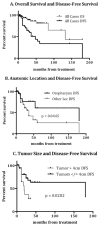Follicular dendritic cell sarcoma of the head and neck: Case report, literature review, and pooled analysis of 97 cases
- PMID: 25917851
- PMCID: PMC4696909
- DOI: 10.1002/hed.24115
Follicular dendritic cell sarcoma of the head and neck: Case report, literature review, and pooled analysis of 97 cases
Abstract
Background: Follicular dendritic cell sarcoma (FDCS) is a rare lymphoid neoplasm presenting in the head and neck. There are no pooled analyses of head and neck FDCS cases in the English language literature.
Methods: A MEDLINE and PubMed review of cases from 1978 to February 2014 was performed. Demographics, clinicopathologic data, and outcomes were summarized.
Results: We presented 2 patients and analyzed 97 cases. The mean age was 42.7 years (SD = 16.3 years). Outcomes were available for 76 patients. Tumors ≤4 cm had better disease-free survival (63% vs 28% at 5 years; p = .0282). Locoregional recurrence was significantly less likely with surgery and radiation compared to surgery alone (15% vs 45%; p = .019) and in patients receiving a neck dissection (10% vs 43%; p = .046).
Conclusion: This pooled analysis provides the largest sample size of FDCS of the head and neck to date and suggests that radiation and neck dissection may be beneficial to locoregional oncologic control. © 2015 Wiley Periodicals, Inc. Head Neck 38: E2241-E2249, 2016.
Keywords: dendritic cell; follicular dendritic cell sarcoma (FDCS); head and neck; sarcoma.
© 2015 Wiley Periodicals, Inc.
Figures




Similar articles
-
Pediatric follicular dendritic cell sarcoma of the head and neck: a case report and review of the literature.Int J Pediatr Otorhinolaryngol. 2013 Jul;77(7):1059-64. doi: 10.1016/j.ijporl.2013.04.015. Epub 2013 May 15. Int J Pediatr Otorhinolaryngol. 2013. PMID: 23684177 Review.
-
Clinical and pathological features of head and neck follicular dendritic cell sarcoma.Hematology. 2015 Dec;20(10):571-83. doi: 10.1179/1607845415Y.0000000008. Epub 2015 Apr 1. Hematology. 2015. PMID: 25831474 Review.
-
[Follicular dendritic cell sarcoma in head and neck region].Cancer Radiother. 2014 Jan;18(1):59-63. doi: 10.1016/j.canrad.2013.10.010. Epub 2013 Dec 25. Cancer Radiother. 2014. PMID: 24373643 French.
-
Extranodal Follicular Dendritic Cell Sarcoma of the Head and Neck Region: A Clinicopathological Study of 7 Cases.Int J Surg Pathol. 2023 Sep;31(6):1067-1074. doi: 10.1177/10668969221133352. Epub 2022 Nov 25. Int J Surg Pathol. 2023. PMID: 36426540
-
Follicular dendritic cell sarcoma of the neck: case report and review of current diagnostic and management strategies.Ear Nose Throat J. 2010 Jul;89(7):E14-7. doi: 10.1177/014556131008900702. Ear Nose Throat J. 2010. PMID: 20628972
Cited by
-
Nodal follicular dendritic cell sarcoma with four atypical histomorphologic features: an unusual case report.Diagn Pathol. 2019 Aug 14;14(1):89. doi: 10.1186/s13000-019-0869-2. Diagn Pathol. 2019. PMID: 31412904 Free PMC article.
-
Profiles of genomic alterations in primary esophageal follicular dendritic cell sarcoma: A case report.Medicine (Baltimore). 2018 Nov;97(48):e13413. doi: 10.1097/MD.0000000000013413. Medicine (Baltimore). 2018. PMID: 30508944 Free PMC article.
-
Clinicopathologic profile of extranodal follicular dendritic cell sarcoma in the mesentery of small intestine: a study of two cases with literature review.Int J Clin Exp Pathol. 2018 May 1;11(5):2372-2376. eCollection 2018. Int J Clin Exp Pathol. 2018. PMID: 31938349 Free PMC article.
-
Tonsillar p16-Positive Follicular Dendritic Cell Sarcoma Mimicking HPV-Related Oropharyngeal Squamous Cell Carcinoma: A Case Report and Review of Reported Cases.Head Neck Pathol. 2021 Mar;15(1):267-274. doi: 10.1007/s12105-020-01152-0. Epub 2020 Mar 18. Head Neck Pathol. 2021. PMID: 32189159 Free PMC article. Review.
-
Follicular dendritic cell sarcoma in the submandibular region: A report of a rare case.J Dent Sci. 2024 Oct;19(4):2430-2432. doi: 10.1016/j.jds.2024.07.022. Epub 2024 Jul 29. J Dent Sci. 2024. PMID: 39347069 Free PMC article. No abstract available.
References
-
- Saygin C, Uzunaslan D, Ozguroglu M, Senocak M, Tuzuner N. Dendritic cell sarcoma: a pooled analysis including 462 cases with presentation of our case series. Crit Rev Oncol Hematol. 2013;88:253–271. - PubMed
-
- Fonseca R, Yamakawa M, Nakamura S, et al. Follicular dendritic cell sarcoma and interdigitating reticulum cell sarcoma: a review. Am J Hematol. 1998;59:161–167. - PubMed
-
- Chan JK, Fletcher CD, Nayler SJ, Cooper K. Follicular dendritic cell sarcoma. Clinicopathologic analysis of 17 cases suggesting a malignant potential higher than currently recognized. Cancer. 1997;79:294–313. - PubMed
-
- Perkins SM, Shinohara ET. Interdigitating and follicular dendritic cell sarcomas: a SEER analysis. Am J Clin Oncol. 2013;36:395–398. - PubMed
Publication types
MeSH terms
Grants and funding
LinkOut - more resources
Full Text Sources
Other Literature Sources
Medical

